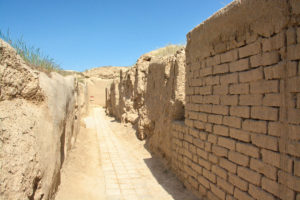 In 18 km to the west of Ashgabat, the ruins of Nisa, the capital of the ancient Parthian state existing at the turn of the 1st millennium BC, rise. E. – 1 thousand n. E. In the III century BC. The New Nisa was the capital of the Parthian state, and the fortress of Old Nisa was a royal residence.
In 18 km to the west of Ashgabat, the ruins of Nisa, the capital of the ancient Parthian state existing at the turn of the 1st millennium BC, rise. E. – 1 thousand n. E. In the III century BC. The New Nisa was the capital of the Parthian state, and the fortress of Old Nisa was a royal residence.
In the Old Nisa were concentrated palace and temple buildings. Also here was a treasury, a huge wine cellar and warehouses with numerous reserves. The fortress walls had a base thickness of 8-9 meters and were fortified with 43 rectangular towers.
 In the era when the Parthian Empire was a world power, Old Nisa was called Mithridatkert, after the name of King Mithradates I (171-138 BC), by whose order it was built. Subsequently, the rulers of Parthia moved the capital to Asia Minor, but a special relation to the Old Nisa was preserved: there were graves of members of the ruling Arsakid dynasty, on great feasts the kings came to Nisa and held sacrifices.
In the era when the Parthian Empire was a world power, Old Nisa was called Mithridatkert, after the name of King Mithradates I (171-138 BC), by whose order it was built. Subsequently, the rulers of Parthia moved the capital to Asia Minor, but a special relation to the Old Nisa was preserved: there were graves of members of the ruling Arsakid dynasty, on great feasts the kings came to Nisa and held sacrifices.
 In the year 226 AD. Parthian kingdom ceased to exist, and the former governor Arsakid Artashir created a new state led by the Sassanid dynasty. Wishing to eradicate people’s memory of all that was associated with the Parthian rulers, he ordered the destruction of the Old Nisa. The ancestral nest of the Arsakids was plundered and practically turned into ruins. Life there resumed only a few centuries later, after Nisa entered the Arab Caliphate; however, the fortress did not reach its
In the year 226 AD. Parthian kingdom ceased to exist, and the former governor Arsakid Artashir created a new state led by the Sassanid dynasty. Wishing to eradicate people’s memory of all that was associated with the Parthian rulers, he ordered the destruction of the Old Nisa. The ancestral nest of the Arsakids was plundered and practically turned into ruins. Life there resumed only a few centuries later, after Nisa entered the Arab Caliphate; however, the fortress did not reach its  former power. Today about the former greatness of Mithridatokert is testified only by finds of archaeologists – beautiful horn-like vessels (rytons) made of ivory, unique documents of II-I centuries. BC, written with the help of a brush on the wreckage of clay shards, amazing white marble sculptures, etc.
former power. Today about the former greatness of Mithridatokert is testified only by finds of archaeologists – beautiful horn-like vessels (rytons) made of ivory, unique documents of II-I centuries. BC, written with the help of a brush on the wreckage of clay shards, amazing white marble sculptures, etc.
The newest find in the Old Nisa is a unique fragment of the fresco – a genuine masterpiece of Parthian painting.
In 2007, Nisa was inscribed on the UNESCO World Heritage List.
